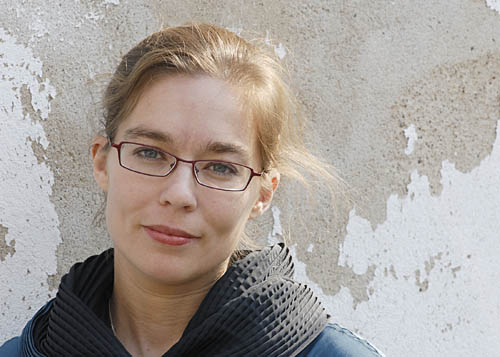Žibuoklė Martinaitytė came into Lithuanian music along with the generation of Raminta Šerkšnytė, Diana Čemerytė, Vytautas V. Jurgutis, Ramūnas Motiekaitis. Together and on her own. She at once stood out among her active, dynamic peers, maybe even estranged herself as a loner, a cosmopolitan, with a clearly felt inner tension, which later, in 2001, exploded like a public confession in the painful, screaming, wild composition Attention! High Tension! for tuba and piano. This tension became the driving force behind her personality and creation.
|

photo: Dmitry Matveyev |
Žibuoklė Martinaitytė is positive that music has special powers. “In each work, I want to ask an existential question and answer it. A work is a state that changes, transforms both its author and its listeners,” the artist says.
Martinaitytė’s aesthetics rejects the idea of creation as play. Even though her works may at first appear colourful and extravagant, in reality they are full of existential pathos. Her acoustic and elecroacoustic compositions do not overindulge in technological tricks, they take one on a journey to the paths of being, sometimes clear and hopeful, sometimes a little ironic, sometimes extreme, sliding down the very blades of emotions. Like an illusionist, the composer crafts an inner space filled with high tension controlled by her alone. Then one becomes the prisoner of the author, sometimes forced to float in that inner space between reality and the transcendental states. One of her best known compositions is actually called Between (2000), commissioned by the Nouvel Ensemble Moderne de Montreal. The maximum use of the instruments’ technical capabilities, intensive exploitation of extreme registers, and the sound of percussion alternating between meditative and expressive moods create an unexpected acoustic effect and an impression of a ritual. These characteristics are typical of much of the composer’s work. Martinaitytė is a master of brass. Her scores present almost impossible tasks for these instruments, but, thanks to her favourite performers Sergej Kirsenko (tuba) and Šarūnas Kačionas (bassoon), they become not only possible, but enchanting in their theatre-like concert nature and glaring virtuosity. And still, instead of enjoying the expressive motorics, wild rhythms and sparkling passages, one feels the almost zen-like test of tension tolerance for both performers and listeners. Martinaitytė shares her emotional life as if provoking the listeners – can they bear her high tension?
The recent years have been surprisingly productive for Žibuoklė. Having lost her father, a special admirer of her work, a year ago, the composer fully absorbed herself in her work, as if building bridges between here and There, between reality and illusion. In April 2006, the British Smith Quartet performed her electroacoustic composition Illusions of Time and Space. In September of the same year, in Toronto, Canada, at the CBC radio’s Glenn Gould studio, the Ergo Ensemble played her Completely Embraced by the Beauty of Emptiness (commissioned by the ensemble itself). This time Martinaitytė’s existential rhetoric acquired an extremely subtle, gently lyrical undertone, well expressed by the title of one of the parts, Unending Variations of Longing, and the illumination of acceptance (the final part, Letting Go).
In October in Vilnius, the accordionist Raimondas Sviackevičius and the Lithuanian Chamber Orchestra (conductor Robertas Šervenikas) presented the composer’s new work titled Breakthrough. She turned the accordion into another high tension conductor, next to tuba, trombone and bassoon. Such legitimation of the accordion as an avant-garde instrument gave the Belgian conductor Daniel Gazon an idea to commission a work for... 6 accordions (!) and an ensemble. In March 2007, the new composition Perpetual Pulsing Transience was performed in Brussels and Mons by the student orchestra of the Mons Royal Conservatoire. “During the moments when we encounter that transience on a very personal level and observe how it is affecting us against our own will... when it’s constantly pulsing in the variety of rhythms... never stopping, never ending – we get overwhelmed and sometimes even paralyzed by it. This particular piece emerged as a creative fight against responses and reactions towards the web of unexpected events I found myself thrown into,“ says the composer.
Martinaitytė is writing a sound diary of her emotions and experiences. Just listen: there’s swirling pain, restless tension and, finally, quiet wisdom in there for you. It may not be safe to open up like this. But is it possible to break an open window?
© Jūratė Katinaitė
Lithuanian Music Link No. 14

